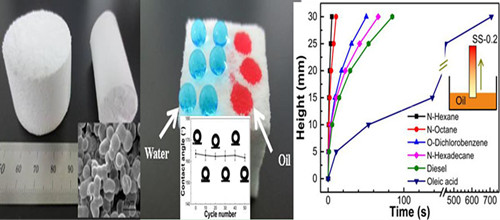Oily products (petroleum and related products, water-immiscible chemicals) have been used for our daily life. The materials, however, may lead to safety and health problems for the human and society if they are not handled properly. For example, the oil spillage occurred in the Gulf of Mexico in 2010 caused serious damage to the ecosystems of the contaminated oceans and coastlines. Therefore, materials that can effectively adsorb and transfer spilled oils and chemicals from water are urgently needed, and the development of such materials has attracted much interest, both academically and practically.
A team led by Prof. MA Pengcheng from Xinjiang Technical Institute of Physics and Chemistry of Chinese Academy of Sciences developed a novel method for the preparation of silicone sponges via a facile sol-gel process. The researchers used commercial silane molecules as precursors, and they prepared ternary silicone sponges with controlled structure and porosity by controlling the degree of hydrolyzation and experimental conditions (pH, temperature).
Researchers put on illustrating the role of functionalities of silane on the morphology, mechanical and thermal properties of silicone sponge. The results showed that the sponge displayed a stable water contact angle above 150°, high efficiency for separating various organic liquids from water with adsorption capacity ranging from 6 to 14 times of its own weight, and an excellent recyclability under cyclic operations. More importantly, researchers found that when putting one end of the strip sponge into the liquid, a spontaneous diffusion process occurred in the sample due to the capillary effect, causing different diffusion speeds and adsorption behaviors. On the basis of this feature, the sponge could be used for the separation of miscible organic liquids.
The results of the study were published in Polymer Chemistry. Part of research was presented as an Invited Talk in the Seventh International Symposium on Engineering Plastics (EP-2015).
The work was supported by the Research Fund for Distinguished Young Scientist in Xinjiang, the Thousand Talent Program, and the Technology Fund for Selected Overseas Chinese from the Ministry of Human Resources and Social Security of China.

Figure : Morphology, Superhydrophobicity and adsorption behavior of sponge towards oily compounds.(Image by XTIPC)
Contact:
Prof.MA Pengcheng
E-mail:mapc@ms.xjb.ac.cn
Xinjiang Technical Institute of Physics & Chemistry,CAS
